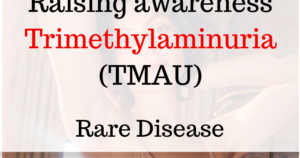What is this disease actually?
Trimethylaminuria causes the body to produce a fishy odor that is released in the sweat, urine, breath, and reproductive fluids. People with trimethylaminuria are unable to break down trimethylamine. Trimethylamine comes from specific chemicals (choline, carnitine, TMAO) found in certain foods. The excess trimethylamine builds up and is the source of the odor. There are no other physical symptoms from trimethylaminuria, but people with this condition may experience serious psychological and social distress. Trimethylaminuria is due to a FMO3 gene that is not working correctly. It is inherited in an autosomal recessive pattern. It is diagnosed based on the symptoms, clinical exam, urine analysis, and can be confirmed by genetic testing. Treatment for trimethylaminuria mainly includes diet modification, acidic soaps and lotions, and vitamin B12 supplements. Other treatment options include antibiotics, activated charcoal, and probiotics.
Trimethylaminuria does not cause any other physical symptoms. However, the odor can interfere with many aspects of daily life, leading to social and psychological problems.
Trimethylaminuria is caused by the FMO3 gene not working correctly. DNA changes known as pathogenic variants are responsible for making genes work incorrectly or sometimes, not at all.
What is the cause of this disease?
Trimethylaminuria is inherited in an autosomal recessive pattern. Some conditions are inherited in an autosomal recessive pattern. All individuals inherit two copies of each gene. Autosomal means the gene is found on one of the numbered chromosomes found in both sexes. Recessive means that both copies of the responsible gene must be altered to have the condition.
People with autosomal recessive conditions inherit one alteration from each of their parents. The parents, who each have one gene alteration, are known as carriers. Carriers of an autosomal recessive condition typically do not have any signs or symptoms (they are unaffected). In some cases, carriers of trimethylaminuria may have mild or occasional symptoms. When two carriers of an autosomal recessive condition have children, there is a 25% (1 in 4) chance to have a child with the condition.

